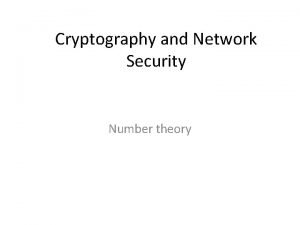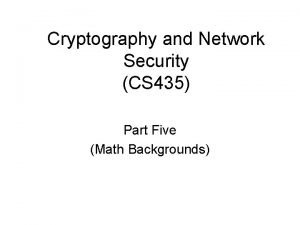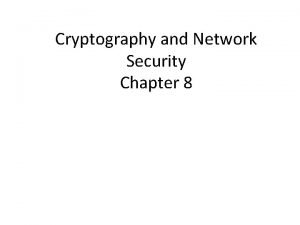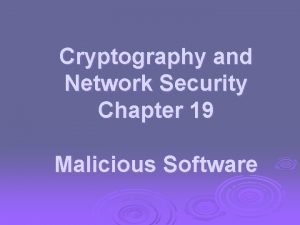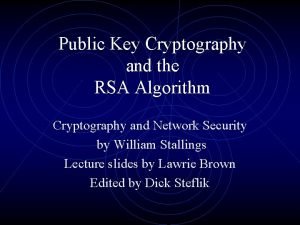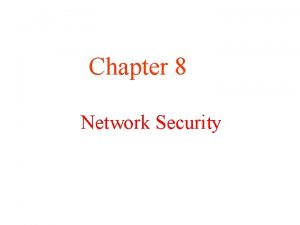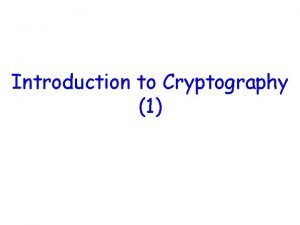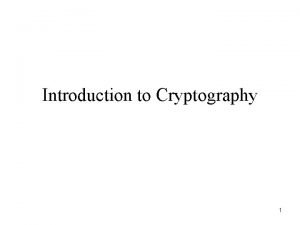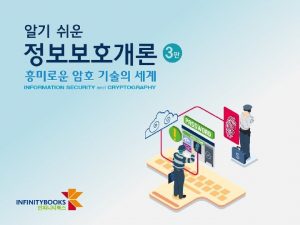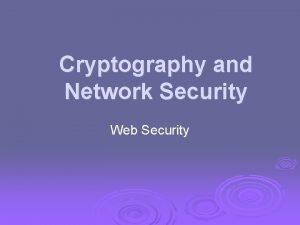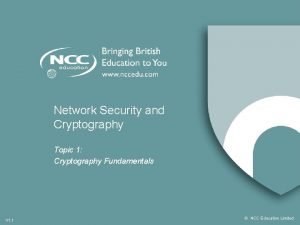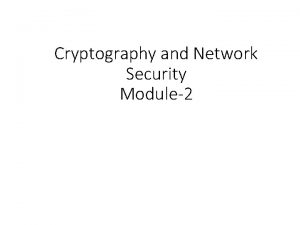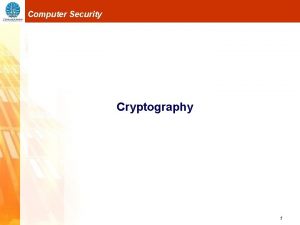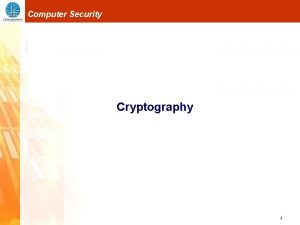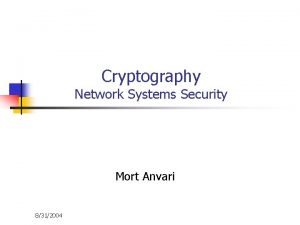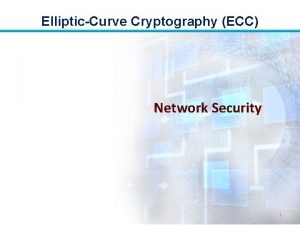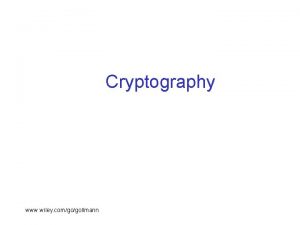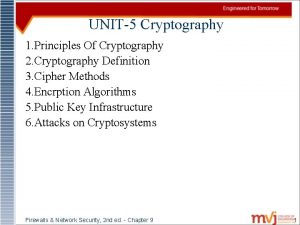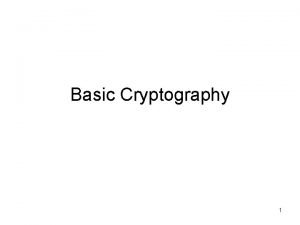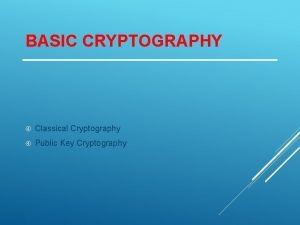Cryptography and Network Security Chapter 1 Introduction Professor























- Slides: 23

Cryptography and Network Security Chapter 1: Introduction Professor Dr. Md. Ismail Jabiullah

Concepts of • • • 2/23 Network Internet The Internet Intranet Extranet Cryptography Security Applications E-commerce Revolutions E-Payments

Topics Ø Ø Ø Background Definitions for: computer, network, internet security Aim of the course Security Trends OSI Security Architecture Aspects of Security l l l Security attacks, Security services, Security mechanisms Model for Network Security Ø Model for Network Access Security Ø 3/23

Background Information Security requirements have changed in recent times Ø Traditionally provided by physical and administrative mechanisms Ø Computer use requires automated tools to protect files and other stored information Ø Use of networks and communications links requires measures to protect data during transmission Ø 4/23

Definitions Computer Security - generic name for the collection of tools designed to protect data and to thwart hackers Ø Network Security - measures to protect data during their transmission Ø Internet Security - measures to protect data during their transmission over a collection of interconnected networks Ø 5/23

Aim of Course Ø Our focus is on Internet Security Ø which consists of measures l l 6/23 To deter, To prevent, To detect, and To correct security violations that involve the transmission & storage of information

Security Trends 7/23

OSI Security Architecture Ø ITU-T X. 800 “Security Architecture for OSI” Ø defines a systematic way of defining and providing security requirements for us Ø it provides a useful overview of concepts that we will study. 8/23

Aspects of Security Ø Consider 3 aspects of information security: l l l 9/23 security attack security mechanism security service

Security Attack Any action that compromises the security of information owned by an organization Ø information security is about how to prevent attacks, or failing that, to detect attacks on information-based systems Ø often threat & attack used to mean same thing Ø have a wide range of attacks Ø We can focus on two generic types of attacks Ø l l 10/23 Passive Attack Active Attack

Passive Attacks 11/23

Passive Attacks 12/23

Active Attacks 13/23

Security Service l l l Enhance security of data processing systems and information transfers of an organization Intended to counter security attacks using one or more security mechanisms often replicates functions normally associated with physical documents • which, for example, have signatures, dates; need protection from disclosure, tampering, or destruction; be notarized or witnessed; be recorded or licensed 14/23

Security Services Ø X. 800: “a service provided by a protocol layer of communicating open systems, which ensures adequate security of the systems or of data transfers” Ø RFC 2828: “a processing or communication service provided by a system to give a specific kind of protection to system resources” 15/23

Security Services (X. 800) Authentication - assurance that the communicating entity is the one claimed Ø Access Control - prevention of the unauthorized use of a resource Ø Data Confidentiality –protection of data from unauthorized disclosure Ø Data Integrity - assurance that data received is as sent by an authorized entity Ø Non-Repudiation - protection against denial by one of the parties in a communication Ø 16/23

Security Mechanism Ø Feature designed to detect, prevent, or recover from a security attack Ø No single mechanism that will support all services required Ø However one particular element underlies many of the security mechanisms in use: l cryptographic techniques Ø Hence, our focus on this topic 17/23

Security Mechanisms (X. 800) Ø Specific security mechanisms: l encipherment, digital signatures, access controls, data integrity, authentication exchange, traffic padding, routing control, notarization Ø Pervasive security mechanisms: l trusted functionality, security labels, event detection, security audit trails, security recovery 18/23

Model for Network Security 19/23

Model for Network Security using this model requires us to: Ø 1. 2. 3. 4. 20/23 Design a suitable algorithm for the security transformation Generate the secret information (keys) used by the algorithm Develop methods to distribute and share the secret information Specify a protocol enabling the principals to use the transformation and secret information for a security service

Model for Network Access Security 21/23

Model for Network Access Security using this model requires us to: Ø 1. 2. Ø 22/23 Select appropriate gatekeeper functions to identify users Implement security controls to ensure only authorised users access designated information or resources trusted computer systems may be useful to help implement this model

That’s All
 Wireless security in cryptography
Wireless security in cryptography Security mechanisms in cryptography
Security mechanisms in cryptography Introduction to cryptography and network security
Introduction to cryptography and network security Introduction to cryptography and network security
Introduction to cryptography and network security Cryptography and network security 6th edition
Cryptography and network security 6th edition Number theory in network security
Number theory in network security Firewall base layer
Firewall base layer Authentication in cryptography and network security
Authentication in cryptography and network security Three classes of intruders in network security
Three classes of intruders in network security Primitive root of a number in cryptography
Primitive root of a number in cryptography Cryptography and network security 6th edition pdf
Cryptography and network security 6th edition pdf Cryptography and network security 7th edition
Cryptography and network security 7th edition Source
Source Cryptography and network security 4th edition
Cryptography and network security 4th edition Euler's theorem in cryptography and network security
Euler's theorem in cryptography and network security Multiplicative inverse
Multiplicative inverse Dsa in network security
Dsa in network security Gcd(1970,1066)
Gcd(1970,1066) Pgp in cryptography and network security
Pgp in cryptography and network security Euler's theorem in cryptography and network security
Euler's theorem in cryptography and network security Malicious software in cryptography
Malicious software in cryptography Rsa algorithm in cryptography and network security
Rsa algorithm in cryptography and network security Promotion from associate professor to professor
Promotion from associate professor to professor Privatesecurity
Privatesecurity














